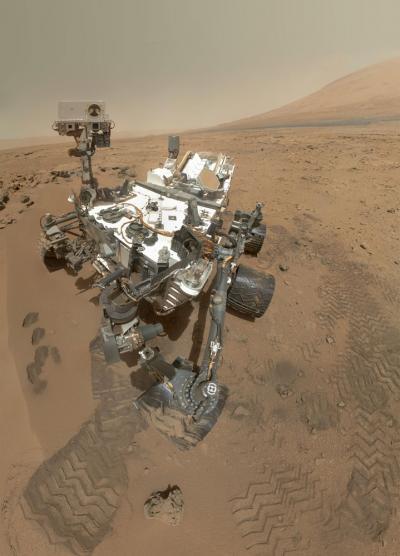The quest for evidence of life on Mars could be more complicated than previously thought due to perchlorate,, a salt comprised of chlorine and oxygen, that interferes with the techniques used by the Curiosity rover to test for traces of life. The chemical causes the evidence to burn away during the tests.
Curiosity is checking Martian soil and rocks for molecules known as organic carbon compounds that are the hallmark of living organisms on Earth but while trekking around the Rocknest sand dune in November 2012, the rover found evidence of perchlorate. When Curiosity heats a scoop of Martian soil to test it for organic carbon, perchlorates can cause a chemical reaction that destroys organic carbon. Daniel Glavin, an astrobiologist at NASA's Goddard Space Flight Center in Greenbelt, Maryland, and first author on the new paper, said he now believes the troublesome perchlorates are likely prevalent throughout the Martian surface.
"The presence of perchlorates isn't good news for some of the techniques we're currently using with Curiosity," said Glavin. "This may change the way we search for organics in the future on Mars."

The Curiosity Rover took this composite self-portrait in the Rocknest sand patch on Mars. Tests of soil at the site suggest that troublesome chemicals called perchlorates are common on the Red Planet. Credit: NASA
Curiosity mission scientists previously announced finding perchlorates last December at the 2012 Fall Meeting of the American Geophysical Union (AGU) and now in the Journal of Geophysical Research: Planets, an AGU publication, they provide much more detail about the evidence and examine its potential impact on Mars exploration.
Accounting for perchlorate
The Curiosity rover's Sample Analysis on Mars (SAM) system tests soil samples by heating them in an instrument, called a pyrolysis gas chromatograph mass spectrometer, which breaks the samples down into their chemical components and determines precisely how much of each of those components is present in the sample. Any perchlorate salts in the heated sample decompose as the temperature goes above 200 degrees Celsius (392 degrees Fahrenheit) and release pure oxygen. Organic molecules in the sample exposed to this oxygen will then combust into carbon dioxide, destroying the molecular evidence of their presence. Luckily, Glavin said, some organic carbon would likely survive, either incased in more heat-resistant materials or detected before the breakdown of perchlorates.
Glavin noted that scientists can account for the destroyed organic carbon by assuming a certain baseline of perchlorate in the Martian soil. In future tests, scientists can calculate how much organic carbon burnt away with the decomposing perchlorates in order to estimate the original amount of organic material in the soil. The findings at Rocknest serve particularly well for this purpose because the site was originally chosen because it was unlikely to have any organic material.
"It will be absolutely critical as we move on to other samples to compare them to the Rocknest dune to infer the presence or absence of Martian organic material," said Glavin.
While Curiosity findings published today in Science do not use Rocknest as a perchlorate baseline, Glavin said the next batch of papers from the Sheepbed mudstone will use them for calibration.
Glavin added that Curiosity has the potential to avoid the perchlorate problem in the future by using techniques that do not involve heating the soil to the point where perchlorates break down. The rover already carries an apparatus capable of that, which it hasn't yet used. The system, which employs liquids in its chemical assays, is more complicated than those currently in operation, Glavin said. And, it requires additional testing before it can be used, which he expects could happen in the near future.





Comments